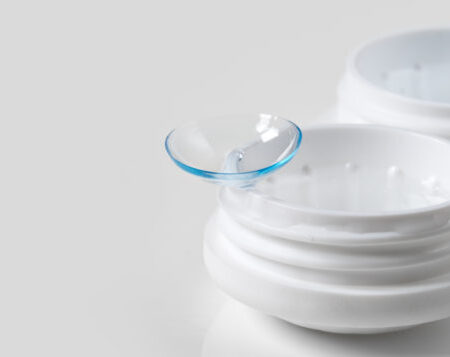Remember when you were just a tyke and made fun of the eyeglasses your granny wore. You asked her why they had such a weird line in them. It’s not so funny now that you’re older and can’t see as well as you did as a kid. If you’re still wearing old-fashioned bifocals, it’s time to cross the line and consider multifocal or bifocal contacts. But first, you need to understand corrective eyewear better than you did as a kid. If you’re asking, how do multifocal contact lenses work? — read on.
What are Multifocal Contact Lenses?
Multifocal contact lenses are designed for people with presbyopia, a common condition brought on by age that makes it more difficult to focus on close-up objects. Typically starting by age 35 to 40, the most obvious sign of presbyopia is holding reading material further away from your eyes in order to focus clearly. At one time, people with presbyopia had to rely on reading glasses, which can be a nuisance because they’re only good for close up vision. Others who already wore glasses for far vision had to switch to bifocals when they developed problems with near vision. Although progressive eyeglasses correct near, intermediate, and far vision without the unsightly lines you made fun of back in the day, some distortion occurs. That’s why multifocal contacts are the preferred option for many people. These contacts can help you see close up, far away, and also correct astigmatism.
Different Types of Bifocal and Multifocal Contacts
Bifocals have two prescriptions, therefore they are considered multifocal, however, not all multifocal contacts are bifocals. Some multifocal lenses have a range of powers in each lens, similar to progressive eyeglasses. Simultaneous vision lenses provide correction for near, far, and often intermediate vision at the same time. Alternating or segmented vision lenses allow a person to switch back and forth between two powers as the pupil moves up and down. Contact lenses are available in the following materials, which dictates to some extent the manufacturing process and available options.
Traditional soft contacts: These lenses are designed to be used on occasion. They are comfortable and the eyes adjust to them with relative ease.
Silicone hydrogel soft lenses: These lenses allow more oxygen to reach the eye than traditional soft lenses. Air Optix Aqua and Biofinity Multifocal are just two of the popular options for individuals looking for multifocals that deliver all-day breathable comfort and natural moisture.
Rigid gas permeable (RGP) lenses: While this material allows oxygen to reach the eyes and can keep them healthier, your eyes can take longer to adjust.
Daily disposables: Highly convenient and cost-effective, these lenses are intended to be discarded and replaced with new ones every day. Quite a few options are available if you’re looking for multifocal dailies.
Hybrid lenses: Featuring an RGP section in the middle and softer material on the outside, these lenses increase comfort and make it easier for your eyes to adapt.
Multifocal Lens Designs
Aspheric: Both distance and near prescriptions are placed in the central vision area, on or close to the pupil. Your eyes adjust to this set up by ignoring close objects when you’re looking at objects far away and vice versa. Many soft disposable lenses available today utilize different variations of aspheric lens designs.
Concentric: Also called annular lenses, near and far prescriptions are arranged in a bulls-eye pattern. The near prescription may be in the middle, with distance correction in the outer ring, or vice versa. Large pupils work better with near vision in the center, whereas far vision placed in the center is better for individuals with small pupils. These are made of either soft or RGP lens materials.
Translating: Near, far, and sometimes intermediate prescription zones are distinct. The pupil moves from one to the other depending on what you’re looking at. The near prescription is typically placed at the bottom of the lens and the distance prescription at the top — like bifocal eyeglasses. This can be reversed for individuals who need the near prescription at the top instead of the bottom. Translating lenses are more commonly manufactured in RGP lens materials than soft lenses.
Segmented bifocals: Made of RGP lens materials, these contacts have two power segments, with an obvious line of separation between the distance correction on top and near correction on the bottom. Like your granny’s specs, your eye looks through one or the other, depending on what you’re focusing on, but the line is barely visible because these contacts are even smaller in diameter than soft contacts. GP segmented lenses can be custom made with a trifocal design, with a small, ribbon-shaped segment for intermediate vision similar to trifocal eyeglasses.
The great news is due to advances in optical science, you don’t need to worry about your grandkids making of fun of you one day … at least not your specs! Many cost-effective and advanced multifocal contact lens options make it easy to cross the line!
Subscribe to our email newsletter to get the latest posts delivered right to your email.

